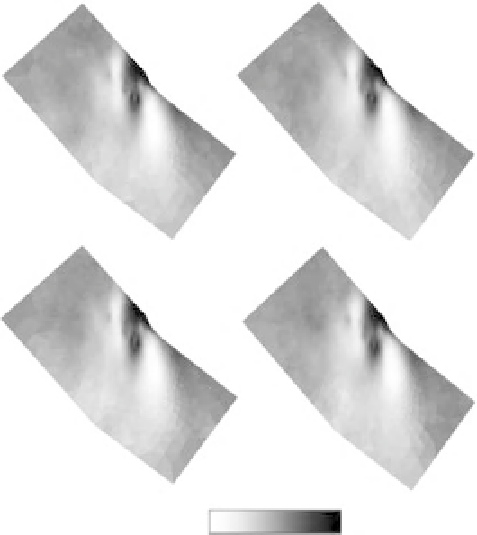Environmental Engineering Reference
In-Depth Information
cost of production and of the hydraulic head drop at
the pumping wells (Figures 8.8c and d). There, one can
also compare the performance of optimal and tradition-
ally based deterministic pumping schemes. The optimal
distribution of wells (and corresponding flow rates) is
reasonable, as observed in Figure 8.8. In general, largest
pumping rates are located at the highly conductive bodies.
This causes small hydraulic head drops and a superior
yield of the pumping scheme. In addition, the total cost
is reduced substantially (to about 10% of the total cost).
Based on those graphs, the decision maker can have a
pretty good idea of the investment required to run the
project and the corresponding uncertainties and risks.
Similarly, the uncertainty on the environmental impact
of the project is evaluated in a stochastic manner for the
two scenarios in Figure 8.8d.
0.3
−
0.6
−
1.5
−
2.3
−
3.2
8.5 Discussion
log
10
T(m
2
/s)
At least three main types of mathematical models are used
in environmental sciences: (1) statistical models that allow
us to summarize the main patterns of variability using
statistical concepts only, (2) deterministic models yielding
a 'unique best' solution based on well established physical
laws and principles, and (3) stochastic models yielding an
ensemble of equally likely solutions of the phenomenon
under study, which can be seen as a combination of a
statistical and deterministic models. This classification
is by no means unique, yet it is useful to illustrate
the strengths and weaknesses of the different modelling
strategies analysed in this chapter.
As pointed out by Prigogine (1997), these model types
have been traditionally rivals. We argue, first, that these
views of nature are complementary. Second, these model
types are more and more applied nowadays in synergy
rather than in competition - the three of them can be
used at different stages of the same project. More inter-
estingly, complex patterns at a small scale are often
difficult to model using a deterministic approach because
the number of unknown parameters intervening in the
characterization is too large. One can, for example, con-
sider the behaviour of individual molecules in a gas
and their interactions. Changing the scale of observa-
tion to a macroscopic one (upscaling) and introducing
macrovariables such as temperature (that can be eas-
ily defined using a statistical approach), one can infer
some new deterministic physical laws that allow us to
understand the global behaviour of the system without
Figure 8.7
Four out of 200 Monte Carlo simulations of the
stochastic transmissivity field (i.e., integral of hydraulic
conductivity along a vertical profile) conditioned to
transmissivity data and available hydraulic head temporal
series.
may not be the optimum if we knew the real distribution of
hydraulic conductivities but it should never be a bad solu-
tion whatever the reality is (if the number of simulations
is large enough, as in this case). Applying those principles,
the optimal pumping network was obtained (Figure 8.8a).
For illustration purposes, we compare its performance
with the one of a deterministic, tradition-based, hand
delineated, pumping scheme configuration (Figure 8.8b).
In broad terms, the most important benefit of the
stochastic approach described above was to allow us to
estimate at any stage of the study the remaining uncer-
tainties and therefore the risks that could be evaluated by
decision and policy makers. This approach was used at a
first stage to estimate the feasibility (both technical and
economical) of the project and later to design the optimal
pumping scheme. At the end of this last stage, uncer-
tainty was still remaining. This effect will be omnipresent
because any new simulation of the hydraulic conductivity
field will add information to the ensemble and, there-
fore, a new set of possibilities with regard to the design
of the pumping network. The uncertainty is depicted
by the cumulative probability density distribution of the





Search WWH ::

Custom Search